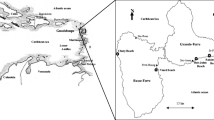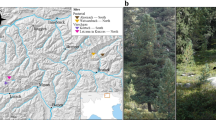Abstract
Using ectomycorrhizal root tip morphotyping (anatomical and morphological identification), molecular analysis (internal transcribed spacer region amplification and sequencing), and fruitbody sampling, we assessed diversity and composition of the ectomycorrhizal fungal community colonizing juvenile Pinus pinaster Ait. under natural conditions in NW Spain. Overall, we found 15 Basidiomycetes and two Ascomycetes. Members of the family Thelephoraceae represented up to 59.4% of the samples. The most frequent species was Tomentella sublilacina followed by Thelephora terrestris, Russula drimeia, Suillus bovinus, and Paxillus involutus, while the less frequent were Pseudotomentella tristis, Lactarius subdulcis, Russula ochroleuca, and Entoloma conferendum. From October 2007 to June 2008, we sampled 208 sporocarps belonging to seven genera and nine species: Thelephora terrestris, Paxillus involutus, Suillus bovinus, Xerocomus badius, Scleroderma verrucosum, Amanita gemmata, A. rubescens, Amanita sp., and Russula sp. The species belonging to the genus Amanita, X. badius and S. verrucosum were not found on root samples. By comparing our results with a bibliographic review of papers published from 1922 to 2006, we found five genera and six species which have not been previously reported in symbiosis with P. pinaster. This is the first time that the diversity of the ectomycorrhizal fungal community associated with P. pinaster was investigated using molecular techniques. Considering that only 38% of the genera found by sequencing were found as fruitbodies, we conclude that integrating morphotyping and sporocarps surveys with molecular analysis of ectomycorrhizas is important to documenting the ectomycorrhizal fungus community.



Similar content being viewed by others
References
Agerer R (ed) (1987–2002) Colour atlas of ectomycorrhizae 1st–12th del. Einhorn, Schwäbisch Gmünd
Ágreda T, Fernández M (2003) Producción micológica en masas de Pinus pinaster Ait.del sudeste de la provincia de Soria. I Congreso Nacional de Micología Forestal Aplicada, Soria, Spain
Bogeat-Triboulot MB, Bartoli F, Garbaye J, Marmeisse R, Tagu D (2004) Fungal ectomycorrhizal community and drought affect root hydraulic properties and soil adherence to roots of Pinus pinaster seedlings. Plant Soil 267:213–223 doi:10.1007/s11104-005-5349-7
Bougoure DS (2006) Ericaceae root associated fungi revealed by culturing and culture-independent molecular methods. PhD dissertation, Centre for Horticulture and Plant Sciences, University of Western Sydney, Sydney, Australia
Burke DJ, Martin KJ, Rygiewicz PT, Topa MA (2005) Ectomycorrhizal fungi identification in single and pooled root samples: terminal restriction fragment length polymorphism (TRFLP) and morphotyping compared. Soil Biol Biochem 37:1683–1694 doi:10.1016/j.soilbio.2005.01.028
Caldwell AB, Jumpponen A, Trappe JM (2000) Utilization of major detrital substrates by dark-septate, root endophytes. Mycologia 92(2):230–232 doi:10.2307/3761555
Consellería de Medio Ambiente (2008) Informe climatolóxico ano 2007. Consellería de Medio Ambiente, Xunta de Galicia
Dahlberg A (2001) Community ecology of ectomycorrhizal fungi: an advancing interdisciplinary field. New Phytol 150:555–562 doi:10.1046/j.1469-8137.2001.00142.x
Egger KN (1995) Molecular analysis of ectomycorrhizal fungal communities. Can J Bot 73:S1415–S1422 doi:10.1139/b95-405
Fernández de Ana Magán FJ, Rodríguez Fernández A (eds) (2000) Os cogumelos nos ecosistemas forestais galegos. Edicións Xerais de Galicia, Vigo, Spain
Fernández-Toirán LM, Ágreda T, Olano JM (2006) Stand age and sampling year effect on the fungal fruit body community in Pinus pinaster forest in central Spain. Can J Bot 84:1249–1258 doi:10.1139/B06-087
Gardes M, Bruns TD (1993) ITS primers with enhanced specificity for basidiomycetes-application to the identification of mycorrhizae and rust. Mol Ecol 2:113–118 doi:10.1111/j.1365-294X.1993.tb00005.x
Gardes M, Bruns TD (1996) Community structure of ectomycorrizal fungi in a Pinus muricata forest: above- and below-ground views. Can J Bot 74:1572–1583 doi:10.1139/b96-190
Gehring CA, Theimer TC, Whitham TG, Keim P (1998) Ectomycorrhizal fungal community structure of pinyon pine growing in two environmental extremes. Ecology 79:1562–1572
Hambleton S (2005) Meliniomyces, a new anamorph genus for root-associated fungi with phylogenetic affinities to Rhizoscyphus ericae (Hymenoscyphus ericae), Leotiomycetes. Stud Mycol 53:1–27
Harley JL, Smith SE (eds) (1983) Mycorrhizal symbiosis. Academic, London
Horton TR (2002) Molecular approaches to ectomycorrhizal diversity studies: variation in ITS at a local scale. Plant Soil 244:29–39 doi:10.1023/A:1020268020563
Horton TS, Bruns TD (2001) The molecular revolution in ectomycorrhizal ecology: peeking into the black-box. Mol Ecol 10:1855–1871 doi:10.1046/j.0962-1083.2001.01333.x
Ingham ER, Molina R (1991) Interactions among mycorrhizal fungi, rhizosphere organisms, and plants. In: Barbosa P, Krischik VA, Jones CG (eds) Microbial mediation of plant–herbivore interactions. Wiley, S. Francisco, pp 169–197
Jonsson L, Dahlberg A, Nilsson M, Zackrisson O, Karen O (1999) Ectomycorrhizal fungal communities in late-successional Swedish boreal forests and composition following wildfire. Mol Ecol 8:205–217 doi:10.1046/j.1365-294x.1999.00553.x
Kåren O, Högberg N, Dahlberg A, Jonsson L, Nylund JE (1997) Inter- and intraspecific variation in the ITS region of rDNA of ectomycorrhizal fungi in fennoscandia as detected by endonuclease analysis. New Phytol 136:313–325 doi:10.1046/j.1469-8137.1997.00742.x
Kõljalg U, Dahlerg A, Taylor AFS, Larsson E, Hallenberg N, Stenlid J, Larsson KH, Fransson PM, Karen O, Jonsson L (2000) Diversity and abundance of resupinate thelephoroid fungi as ectomycorrhizal symbionts in Swedish boreal forest. Mol Ecol 9:1985–1996 doi:10.1046/j.1365-294X.2000.01105.x
Kõljalg U, Larsson K-H, Abarenkov K, Nilsson RH, Alexander IJ, Eberhardt U, Erland S, Hoiland K, Kjoller R, Larsson E, Pennanen T, Sen R, Taylor AFS, Tedersoo L, Vralstad T, Ursing BM (2005) UNITE: a database providing web-based methods for the molecular identification of ectomycorrhizal fungi. New Phytol 166:1063–1068 doi:10.1111/j.1469-8137.2005.01376.x
Macías F, Calvo de Anta R (2008) Mapas de solos de Galicia Escala 1:50000. Consellería de Medio Ambiente e Desenvolvemento Sostible. Xunta de Galicia
Martín-Pinto P, Vaquerizo H, Peñalver F, Olaizola J, Oria-de-Rueda JA (2006) Early effects of a wildfire on the diversity and production of fungal communities in Mediterranean vegetation types dominated by Cistus ladanifer and Pinus pinaster in Spain. For Ecol Manage 225:296–305
Massicotte HB, Molina R, Tackaberry LE, Smith JE, Amaranthus MP (1999) Diversity and host specificity of ectomycorrhizal fungi retrieved from three adjacent forest sites by five host species. Can J Bot 77:1053–1073 doi:10.1139/cjb-77-8-1053
Menkis A, Vasiliauskas R, Taylor AFS, Stenlid J, Finlay R (2005) Fungal communities in mycorrhizal roots of conifer seedlings in forest nurseries under different cultivation systems, assessed by morphotyping, direct sequencing and mycelial isolation. Mycorrhiza 16:33–41 doi:10.1007/s00572-005-0011-z
Ministerio Medio Ambiente (2006) Tercer Inventario Forestal Nacional (1997–2006). Madrid
Molina R, Massicotte HB, Trappe JM (1992) Specificity phenomena in mycorrhizal symbiosis: community-ecological consequences and practical implications. In: Allen MF (ed) Mycorrhizal functioning: an integrative plant–fungal process. Routledge, New York, USA, pp 357–423
Nylund JE, Dahlberg A, Högberg N, Karén O, Grip K, Johnsson L (1995) Methods for studying species composition of mycorrhizal fungal communities in ecological studies and environmental monitoring. In: Stocchi V, Bonfante P, Nuti M (eds) Biotechnology of ectomycorrhizae. Plenum, New York, pp 229–239
Pera J, Álvarez IF (1995) Ectomycorrhizal fungi of Pinus pinaster. Mycorrhiza 5:193–200 doi:10.1007/BF00203337
Sakakibara SM, Jones MD, Gillespie M, Hagerman SM, Forrest ME, Simard SW, Durall DM (2002) A comparison of ectomycorrhiza identification based on morphotyping and PCR-RFLP analysis. Mycol Res 106:868–878 doi:10.1017/S0953756202006263
Smith SE, Read D (eds) (1997) Mycorrhizal symbiosis. Academic, San Diego
Taylor AFS, Alexander I (2005) The ectomycorrhizal symbiosis: life in the real world. Mycologist 19:102–111 doi:10.1017/S0269915X05003034
Taylor DL, Bruns TD (1999) Community structure of ectomycorrhizal fungi in Pinus muricata forest: minimal overlap between the mature forest and resistant propagule communities. Mol Ecol 8:1837–1850 doi:10.1046/j.1365-294x.1999.00773.x
Tedersoo L, Kõljalg U, Hallenberg N, Larsson KH (2003) Fine scale distribution of ectomycorrhizal fungi and roots across substrate layers including coarse woody debris in a mixed forest. New Phytol 159:153–165 doi:10.1046/j.1469-8137.2003.00792.x
Trevor E, Yu J-C, Egger KN (2001) Ectendomycorrhizal associations-characteristics and functions. Mycorrhiza 11:167–177 doi:10.1007/s005720100110
Wurzburger N, Bidartondo MI, Bledsoe CS (2001) Characterization of Pinus ectomycorrhizas from conifer and pygmy forest using morphotyping and molecular methods. Can J Bot 79:1211–1216 doi:10.1139/cjb-79-10-1211
Acknowledgements
Funding was provided in part by the European Social Fund and by the Ministerio de Ciencia e Innovación of the Spanish Government through the project RTA2006-00124-00-00. Montserrat Pestaña Nieto has a pre-doctoral grant provided by the local government of Galicia (Conselleria de Medio Ambiente, Xunta de Galicia). We thank Dr. Christopher D. Beatty for checking English and Jose Gómez Bragaña for the help during field samplings.
Author information
Authors and Affiliations
Corresponding author
Electronic supplementary material
Below is the link to the electronic supplementary material.
ESM
(DOC 85.5 KB).
Rights and permissions
About this article
Cite this article
Pestaña Nieto, M., Santolamazza Carbone, S. Characterization of juvenile maritime pine (Pinus pinaster Ait.) ectomycorrhizal fungal community using morphotyping, direct sequencing and fruitbodies sampling. Mycorrhiza 19, 91–98 (2009). https://doi.org/10.1007/s00572-008-0207-0
Received:
Accepted:
Published:
Issue Date:
DOI: https://doi.org/10.1007/s00572-008-0207-0




